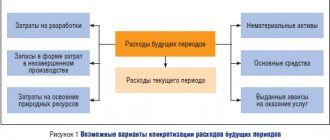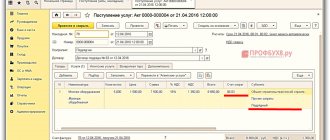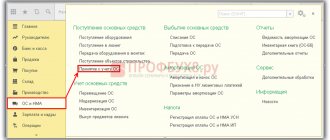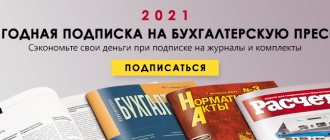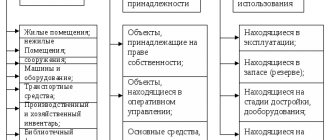Since 2021, the Federal Accounting Standard FSBU 5/2019 “Inventories” has been in force, approved. by order of the Ministry of Finance of Russia dated November 15, 2019 No. 180n. Working clothes, special equipment and other low-value items with a service life of more than 12 months are no longer included in reserves. 1C experts tell how in “1C: Accounting 8” edition 3.0 you can take into account low-value equipment and inventories in accordance with changes in accounting and recommendations of the Accounting Methodological Center *.
* Accounting methodological) is a subject of non-state regulation of accounting within the competencies established by Article 24 of the Federal Law of December 6, 2011 No. 402-FZ.
By Order of the Ministry of Finance of Russia dated November 15, 2019 No. 180n, the Federal Accounting Standard FSBU 5/2019 “Inventories” was approved. FSB 5/2019 applies starting from reporting for 2021. In order No. 180n we are faced with two interesting points.
Course in the Educational “Accounting according to FAS 5/2019 “Inventories” in 1C: Accounting 8”
Firstly
, with the cancellation of the Guidelines for accounting of special tools, special devices, special equipment and special clothing (approved by order of the Ministry of Finance of Russia dated December 26, 2002 No. 135n).
Secondly
, with new wording in the definition of inventories: “For accounting purposes, inventories are assets consumed or sold within the normal operating cycle of the organization, or used for a period of no more than 12 months” (clause 3 of FSBU 5/2019).
Thus, in 2021, the concept of workwear and special equipment no longer exists in accounting. Now these are either materials or fixed assets (fixed assets). In this article we will look at the features of accounting for fixed assets in 2021.
About support for FSB 5/2019 in “1C: Accounting 8 CORP” edition 3.0, read:
FSBU 5/2019: methods for assessing finished products in “1C: Accounting 8 KORP”
FSBU 5/2019: impairment of inventories in 1C: Accounting 8 KORP
On the accounting of materials in accordance with FSBU 5/2019, see the video recording of the lecture “FSBU 5/2019 “Inventories” - fundamental differences compared to the current standard, reflected in the program “1C: Accounting 8″” with the participation of O.A. Sukhareva (Director of the National Budgetary Institution "BMC" Foundation) and 1C experts. The video is available for viewing on the 1C:ITS website on the 1C:Lecture page.
Concept and composition of fixed assets
The fixed assets of an enterprise include assets that have a material expression and strictly meet the criteria established by law, which we will discuss in more detail in the next section of the article.
Such assets include buildings, structures, machinery, equipment, instruments intended for measurements and adjustments, computers, transport, tools, equipment, road infrastructure, as well as other types of assets.
In agricultural organizations, fixed assets include breeding and draft animals and perennial plants.
It is possible to include land plots, capital investments for their improvement (for example, reclamation or irrigation work), as well as natural resources such as water, subsoil, etc.
IMPORTANT! Objects of tangible assets do not belong to fixed assets if they are located in the warehouses of trading or manufacturing enterprises that manufacture them. In this case, they are accounted for as goods held for sale or as finished goods.
The accounting policies (hereinafter referred to as the AP) of organizations may provide for a cost limit, below which assets that meet the criteria for recognition as fixed assets in accounting can be classified as inventories. In this case, the specified limit should not exceed 40,000 rubles. (paragraph 4, clause 5 of the Regulations on OS accounting (PBU 6/01)).
IMPORTANT! Fixed assets, the use of which is limited to leasing, are recognized in accounting and reporting as profitable investments in material assets.
As a general rule, capital investments do not belong to the fixed assets of an enterprise (clause 3 of PBU 6/01). Capital investments in leased fixed assets can be included in their composition (paragraph 2, paragraph 5 of PBU 6/01).
How to apply PBU 6/01 for low-value operating systems in 2021
But what should organizations do that have not yet switched to using FSBU 6/2020 in 2021? How to apply PBU 6/01 and at the same time take into account low-value fixed assets?
We believe that to answer the question about accounting for low-value fixed assets in 2021, you can use the recommendation of the Accounting Methodological Center (BMC) No. R-100/2019-KpR “Implementation of the requirement of rationality” (approved by the NRBU BMC Foundation on May 29, 2019).
Illustrative Example 1 of Recommendation No. R-100/2019-KpR proposes the following procedure for accounting for fixed assets:
- instead of applying the cost limit provided for in paragraph 5 of PBU 6/01 for individual fixed assets, it is possible to identify groups of fixed assets, information about which is obviously insignificant, based on the characteristics of the organization’s activities and the structure of its assets;
- this decision must be reviewed regularly (at least once a year);
- if this decision is made, costs for the acquisition, creation, improvement of fixed assets related to selected non-essential groups, regardless of the cost of individual objects, are written off as expenses for ordinary activities at the time they are incurred;
- objects belonging to significant groups, regardless of the cost of individual objects, are taken into account in the general procedure for accounting for fixed assets.
So, for example, the management of a plant may decide that all costs for the purchase of office equipment and computers for accounting, within a certain amount per year, are not significant for financial statements and can be written off as expenses (even if a separate copying machine costs 150 thousand rubles. ).
And according to the recommendation of the BMC No. R-122/2020-KpR “Special means of production” (approved by the NRBU “BMC” Foundation on December 11, 2020), the concept of materiality given in paragraph 7.4 of PBU 1/2008 can be applied to all low-value objects , regardless of the period of their use. Based on the requirement of rationality, an organization can decide from 01/01/2021 to include expenses for ordinary activities at the time when expenses were incurred for the acquisition, creation, improvement of special means of production, the cost of which individually and in the aggregate of a homogeneous group is insignificant, regardless of their period of use.
At the same time, assets that meet the criteria of fixed assets, with a useful life of more than 12 months and a value within the limit established by the organization (but not more than 40,000 rubles), can be reflected in accounting as part of the inventory, as before, i.e. before FSBU 5/2019 comes into force. This conclusion was made by the Russian Ministry of Finance in letter dated 03/02/2021 No. 07-01-09/14384.
1C:ITS
For more information on how to keep records of special clothing (special equipment) with a service life of more than 12 months in accounting and tax accounting in 2021, see the “Legislative Consultations” section.
What is included in the group of fixed assets: criteria
In order to recognize property as an item of fixed assets, 4 more basic conditions must be met:
- this object must be used in business activities;
- the use of the object must continue for more than 12 months;
- the object is not acquired or created for sale, and such sale is not expected in the near future;
- the use of an OS object must generate income for the organization.
Despite the fact that PBU 6/01 provides only 4 requirements, we believe that, as an additional criterion for recognizing fixed assets in accounting, it is worth considering the possibility of determining the initial cost of fixed assets.
Thus, PBU 6/01 contains a specific indication that fixed assets are accepted in accounting at their original cost. Consequently, the impossibility of its definition should cast doubt on any possibility of recognizing OS.
For the application of the above criteria, see the article “PBU 6/01 - Accounting for fixed assets in 2021 (nuances)”.
Accounting for capital investments in leased fixed assets
Capital investments made in leased fixed assets can also be recognized as fixed assets. In this situation, 2 options are possible: when the lessor compensates for the cost of capital investments and when he does not compensate for such costs.
In the 1st option, such investments in leased property do not form an asset for the tenant, since then the result of these investments belongs to the lessor. Such costs are accumulated in the capital investment account with their subsequent write-off to the account for settlements with the lessor.
In the 2nd option, accordingly, capital investments after their completion can form the cost of a separate fixed asset item.
This procedure is provided for in clause 35 of the Methodological Guidelines for Accounting for Fixed Assets (Order of the Ministry of Finance of Russia dated October 13, 2003 No. 91n).
In the event that the lessor reimburses, for example, not the entire cost of capital investments, but minus depreciation, part of the value not reimbursed in this order may also form the cost of a separate fixed asset.
Example of registering a fixed asset
On February 10, the company purchased industrial equipment for the production of pipes worth RUB 156,000, incl. VAT RUB 23,797 An engineer was sent to the plant to pick up the equipment, and his travel allowance amounted to 2,000 rubles. Transportation and installation costs amounted to RUB 24,500, incl. VAT 3737 rub. It was put into operation in April.
The initial cost of the object will be 154,966 rubles, including:
- Amount paid to the supplier (excluding VAT) – RUB 132,203;
- Business trip costs – 2000 rubles;
- Transportation and installation costs (excluding VAT) – RUB 20,763.
Let's formalize our data with postings:
- Dt60 Kt51 – 156,000 rubles, payment to the supplier for the purchase of fixed assets;
- Dt07 Kt60 – 132,203 rubles, the amount of the purchased object excluding VAT;
- Dt19 Kt60 – RUB 23,797, including VAT from the supplier;
- Dt08 Kt07 – RUB 132,203, equipment handed over for installation;
- Dt08 Kt71 – 2000 rubles, the amount of travel expenses is included in the cost of the operating system;
- Dt08 Kt60 – 20,763 rubles, the cost of transportation and installation is included in the cost of the OS;
- Dt19 Kt60 – RUB 3,737, VAT included;
- Dt60 Kt51 – 24,500 rubles, payment for services rendered is transferred;
- Dt01 Kt08 – RUB 154,966, OS put into operation;
- Dt68 Kt19 – RUB 27,534, VAT deductible.
Depreciation begins in the month of May using the straight-line method. The SPI for equipment is 5 years. The initial cost of the OS is 154,966 rubles. Let's calculate depreciation:
- 154966/60(month)=2582.77 rub. – monthly depreciation amount for 5 years.
- Dt20 Kt02 – 2582.77 rubles, depreciation accrued.
To approve business activities at the enterprise, record all operations necessary for business in the Regulations on Accounting Policies, including those for fixed assets. The tax office often requires you to provide accounting policies with documents.
Differences in accounting and tax accounting of fixed assets
In general, both PBU 6/01 and the Tax Code of the Russian Federation contain similar definitions of OS. The main differences can be summarized as follows:
- For accounting purposes, the All-Russian Classifier of Fixed Assets OK 013-94 is used (Resolution of the State Standard of the Russian Federation dated December 26, 1994 No. 359). Starting from 01/01/2017, this document will no longer be valid and a new classifier will be used - OK 013-2014 (Rosstandart order dated 04/21/2016 No. 458). At the same time, for tax purposes they use the Classification of fixed assets included in depreciation groups (Resolution of the Government of the Russian Federation dated January 1, 2002 No. 1).
- Since January 1, 2016, the Tax Code of the Russian Federation contains a condition according to which property worth more than 100,000 rubles is included in the OS. (Clause 1 of Article 257 of the Tax Code of the Russian Federation). As we noted earlier, in accounting the threshold for recognizing property as fixed assets is 40,000 rubles.
Results
Fixed assets are an important component of the property of any enterprise. Correct qualification of objects that are classified as fixed assets is the key not only to the correct accounting of such assets, but also to the ability to manage the costs of the enterprise and avoid undesirable tax consequences.
Fixed assets are material objects that are used by an organization for a long time in the process of producing products (performing work, providing services) or for management needs. Fixed assets include, for example, buildings and structures, machinery and equipment, computer technology, vehicles, household equipment, productive and breeding livestock, perennial plantings, etc.
At the same time, in order to recognize the above objects as fixed assets (fixed assets) in accounting and tax accounting, certain conditions must be met, which we will discuss in our consultation.
What are fixed assets?
In order to increase the efficiency of an enterprise or business, you need to understand how to manage its assets, which include fixed assets. But before moving on to the analysis of ratios and management, it is necessary to understand what fixed assets are, what their structure is and what classifications of fixed assets exist.
To begin with, all the property of the enterprise is represented by fixed assets and inventories.
Fixed assets are means of labor that are repeatedly involved in the production process, while maintaining their natural form, transferring their value to the manufactured products in parts as they wear out in the form of depreciation. These include means of production with a service life of more than 12 months.
Thus, the following conclusions can be drawn.
Firstly, fixed assets last a long time.
Secondly, their cost is gradually included in the cost of products or services. And why? Yes because they are expensive. If you include all the cost at once, the profit will be uneven. And it is likely that if a company has a small turnover, a loss may occur. It is in order to avoid this problem that the depreciation mechanism was invented.
In addition, since fixed assets are usually expensive, additional investment resources are often used to acquire them. At the same time, financing for the acquisition of fixed assets can be carried out from various sources.
OS in accounting
In the accounting of an organization, in order to recognize an asset as an item of fixed assets, it is necessary that the following conditions be met in relation to such an item:
- the object is intended to be used for any of the following purposes (clause 4 of PBU 6/01):
- production of products;
- execution of work;
- provision of services;
- management needs of the organization;
- provision for a fee for temporary possession or use.
- the object is intended for use for a period of time exceeding 12 months;
- the organization does not intend to subsequently resell the asset;
- the object is capable of bringing future economic benefits to the organization.
The above means that they are not fixed assets, in particular (clause 3 of PBU 6/01):
- machines, equipment, and other similar objects that are listed as finished products in the manufacturer’s warehouse or as goods in the warehouse of a trading organization;
- objects that have been commissioned for installation or are to be installed, and are also in transit;
- capital and financial investments.
Let us explain what has been said with examples.
Objects of fixed assets are accounted for by the organization on active account 01 “Fixed assets” (Order of the Ministry of Finance dated October 31, 2000 No. 94n). If we are talking about finished products, then they are accounted for in account 43 “Finished Products”, and goods must be accounted for in account 41 “Goods”. If the organization decides to use the finished products produced by the organization or purchased goods as an object of fixed assets, it is necessary to first reflect the formation of its initial value in the usual manner on account 08 “Investments in non-current assets” (Order of the Ministry of Finance dated October 31, 2000 No. 94n) :
Debit of account 08 – Credit of accounts 43, 41, 10 “Materials”, 60 “Settlements with suppliers and contractors”, 70 “Settlements with personnel for wages”, 69 “Settlements for social insurance and security”, etc.
And then the already formed initial cost of the fixed assets object is included in the debit of account 01:
How to account for the acquisition (creation) of fixed assets
Determining whether the property is a fixed asset
Property that has a tangible form is accepted as part of fixed assets if the following recognition conditions are simultaneously met in relation to it:
— it is intended for use in the activities of the organization, including in the production of products, when performing work, providing services, for the management needs of the organization, as well as for provision for temporary use (temporary possession and use);
— the organization expects to receive economic benefits from its use;
- the property is intended for use for a period of more than 12 months from the date of acquisition;
— the organization does not intend to alienate it within 12 months from the date of acquisition;
— the initial cost of property can be reliably determined (part 1, clause 4 of the Instructions for Accounting for Fixed Assets).
At the same time, assets such as inventory, household supplies, tools, equipment and fixtures (hereinafter referred to as inventory) can be taken into account both as part of inventories and as part of fixed assets (paragraph 3, paragraph 3, paragraph 7, paragraph 4 of the Instructions on inventory accounting). The list of inventory is not defined by law, and therefore an organization can develop it and consolidate it in its accounting policies.
When developing this list, the organization can use the resolution on establishing the standard service life of fixed assets, which contains a list of property related to inventory and accessories.
When compiling a list of inventory, it is necessary to proceed from the appropriateness of including various types of property and economic feasibility.
Perennial wild plant objects growing in natural conditions on the territory of the organization are not considered fixed assets. At the same time, wild plants are plants that are in their natural growing environment and are capable of forming populations, plant communities (Part 3, Clause 4 of the Instructions for Accounting for Fixed Assets, Article 1 of the Law of the Republic of Belarus dated June 14, 2003 N 205-Z “On Plants”) world").
We form the initial cost of the fixed asset
Fixed assets are accounted for in accounting at their original cost (paragraph 2, clause 2 of the Instructions for Accounting for Fixed Assets).
The initial cost of acquired fixed assets is formed from the actual costs of their acquisition, which include:
— the cost of the acquired fixed asset;
— customs duties and payments;
— interest on loans and borrowings;
— insurance costs upon delivery;
— costs of bringing fixed assets into a condition suitable for use (for example, costs of installing equipment if the equipment requires installation);
- other costs associated with the acquisition (part 1, clause 10 of the Instructions for Accounting for Fixed Assets).
The list of other costs associated with the acquisition of fixed assets and included in the initial cost of fixed assets is not defined by law. In this regard, the organization can independently determine such costs. The exception is expenses that, according to the law, are not subject to inclusion in the initial cost of fixed assets.
If an organization, when accepting fixed assets for accounting, has obligations to carry out work on the dismantling and liquidation of these fixed assets, restoration of natural resources on the land plots they occupy, then the initial cost of such fixed assets includes the amount of the created reserve for the decommissioning of fixed assets and similar obligations (part 2, clause 10, clauses 23 - 25 of the Instructions for Accounting for Fixed Assets).
The initial cost of created in an organization is determined in the amount of actual direct and distributed variable indirect costs for their creation, with the exception of cases established by law (Part 3, Clause 10 of the Instructions for Accounting for Fixed Assets).
We accept the fixed asset for accounting
The generated initial cost of fixed assets is reflected in account 01 “Fixed Assets” (part 5, clause 11 of the Instructions for Accounting for Fixed Assets):
a) when purchasing a fixed asset:
- if it does not require installation - on the date of its purchase. If a fixed asset is subject to mandatory state registration, certification, etc., then it is taken into account as part of fixed assets after carrying out the appropriate procedures for registration, certification, etc. (part 1, 4 clause 4 of the Instructions for accounting of fixed assets);
- if it requires installation - after installation work (part 6, 8, clause 12, part 9, clause 13 of the Instructions on the application of the chart of accounts);
b) during the construction of a fixed asset - after acceptance of the object into operation in the prescribed manner and approval of the act of acceptance of the object into operation. Let us note that objects (parts of an object), completed by construction and accepted into operation, subject to mandatory state registration in accordance with the legislation, are accepted for accounting as fixed assets after state registration of ownership of them (clause 40, Instructions No. 10);
c) when creating a fixed asset - after completion of work on its creation.
Registration of fixed assets is carried out on the basis of an act of acceptance and transfer of fixed assets (clause 9 of the Instructions for accounting of fixed assets).
When acquiring (creating) fixed assets, the following entries are made in accounting (parts 4, 5, clause 11 of the Instructions for Accounting for Fixed Assets).
| Business transactions | Account correspondence |
| Costs for the acquisition (creation, construction) of fixed assets are reflected (excluding VAT) | if the main asset does not require installation: D-t 08 - K-t 60 (02, 10, 70, 69, 76, etc.) |
| if installation is required: D-t 07 - K-t 60; Dt 08 - Kt 07 | |
| Fixed asset accepted for accounting | D-t 01 - K-t 08 |
The accounting unit for fixed assets is an inventory item, which can be:
(or) an object with all fixtures and accessories;
(or) a separate structurally isolated object intended to perform certain independent functions;
(or) a separate complex of structurally articulated objects (hereinafter referred to as the complex), representing a single whole and intended to perform a specific job. In this case, a complex is one or several items that have common devices and accessories, common control, are mounted on the same foundation, and each item can perform its functions only as part of the complex.
However, if a fixed asset consists of parts that have different useful lives, then each such part is accepted for accounting as a separate inventory item of fixed assets (clause 6 of the Instructions for Accounting for Fixed Assets).
We determine the standard service life and useful life of the fixed asset
Objects of fixed assets listed in the accounting records of an organization are subject to depreciation (with the exception of those listed on off-balance sheet accounts, as well as individual objects of fixed assets) (clause 11 of the Instructions on the procedure for calculating depreciation).
In order to calculate depreciation on fixed assets, it is necessary to determine their standard service life (NSL) and (or) useful life (SPI) (clauses 17, 19 of the Instructions on the procedure for calculating depreciation).
As a general rule, NSS OS is determined upon their acquisition from the date of acceptance of OS for accounting in accordance with the appendix to Resolution N 161, depending on the types of OS in accordance with their classification (Part 1, Clause 17, Part 1, Clause 18 of Instruction No. 37/18/6).
SPI is the expected or estimated period of operation of the OS in the process of business activity, which is established by the commission (clause 19 of Instruction No. 37/18/6). In this case, the SPI is established in years (the corresponding number of months) within the limits between the lower and upper limits of the ranges (accurate to two decimal places) for groups of depreciable fixed assets, taking into account the coefficients established by Appendix 3 to Instruction No. 37/18/6 (h 1 clause 21 of Instruction No. 37/18/6).
We calculate and reflect depreciation in accounting
Depreciation is calculated:
- for fixed assets used in business activities - based on the selected SPI in linear, non-linear and productive ways;
- for objects not used in business activities - based on the NSS in a straight-line manner (clause 37 of the Instructions on the procedure for calculating depreciation).
We apply an investment deduction
The investment deduction for fixed assets is used in tax accounting and allows you to include part of the initial cost of fixed assets used in business activities .
These include:
- buildings, with the exception of residential buildings (parts thereof) (except for rental housing, dormitories, built-in and attached non-residential premises in residential buildings), buildings of cultural and entertainment (night) clubs, buildings used for activities in the gambling business, hotel buildings and other buildings for short-term accommodation (except for those related to roadside service facilities), mobile buildings (including prefabricated and mobile buildings);
— transfer devices;
- structures, with the exception of structures for recreational areas and zoos, structures for parking or car parking;
— machinery and equipment, vehicles, with the exception of those intended and (or) used to carry out activities in the gambling business.
Moreover, buildings, transmission devices, structures, machinery and equipment, and vehicles include fixed assets (parts thereof), defined as such under the legislation regulating the standard service life of fixed assets (Part 2, Part 5, Subclause 2.2, Article 170 NK).
Note! The Tax Code defines a list of objects for which investment deductions do not apply.
The size of the investment deduction is determined by the organization independently within the limits established by law (paragraph 2, 3, part 2, subparagraph 2.2 of Article 170 of the Tax Code).
| Names of fixed assets | Maximum amount of investment deduction |
| Buildings, structures, transmission devices | 15% of original cost |
| Machinery, equipment, vehicles (except for passenger cars, except those classified as special, as well as those used to provide taxi services) | 30% of original cost |
The investment deduction is calculated as follows.
The amount of the investment deduction is included in the costs taken into account when taxing profits for two years, starting from the reporting period , which is the month in which depreciation began to accrue in accordance with the law (paragraph 2, part 3, subclause 2.2 of Article 170 of the Tax Code).
Read this material in ilex >>*
* following the link you will be taken to the paid content of the ilex service
